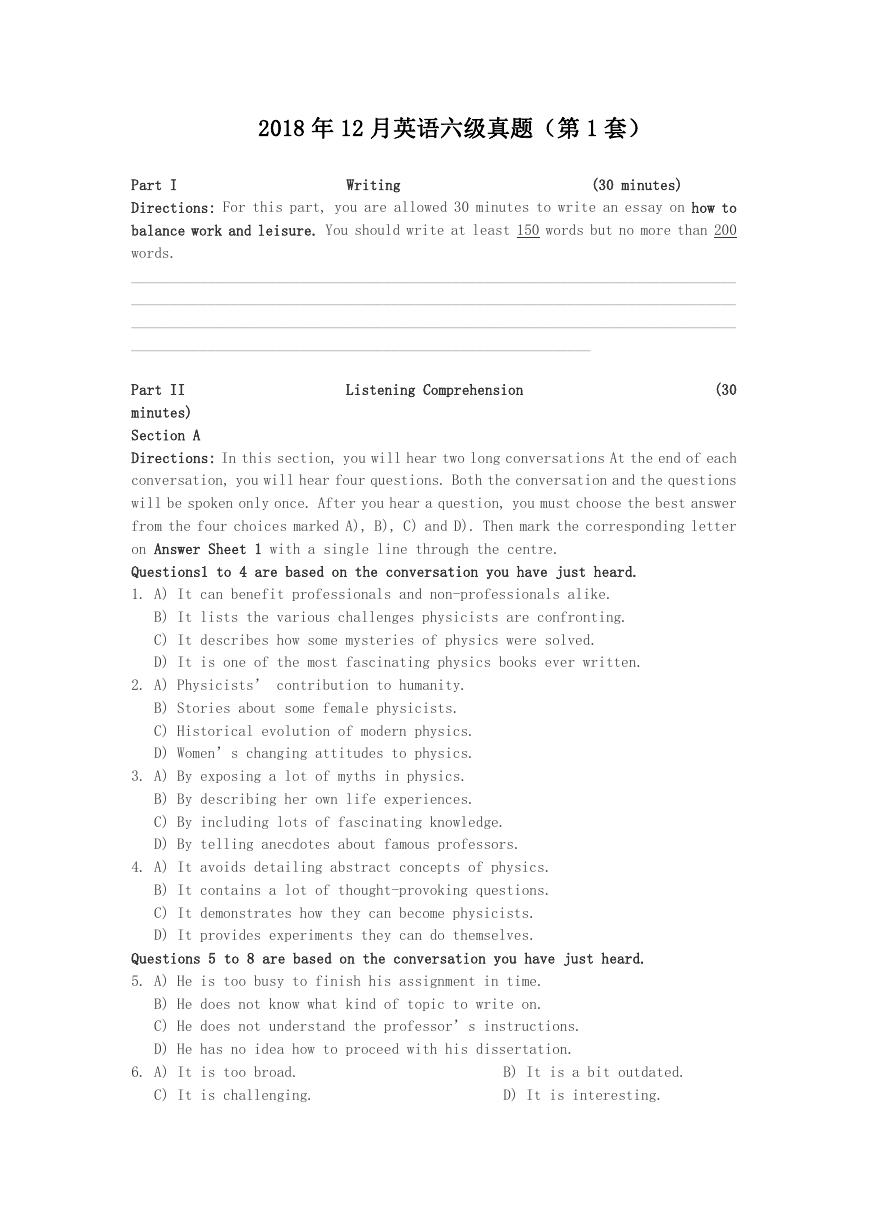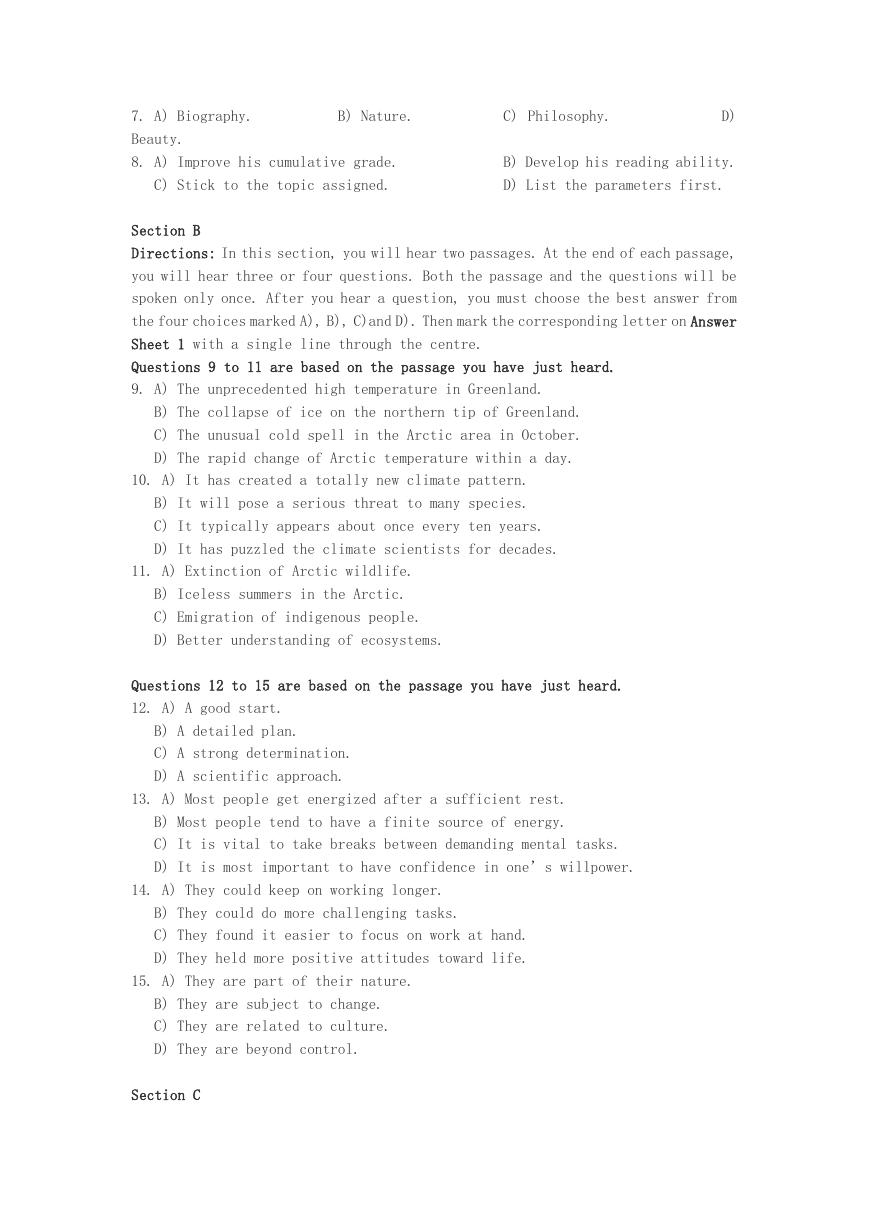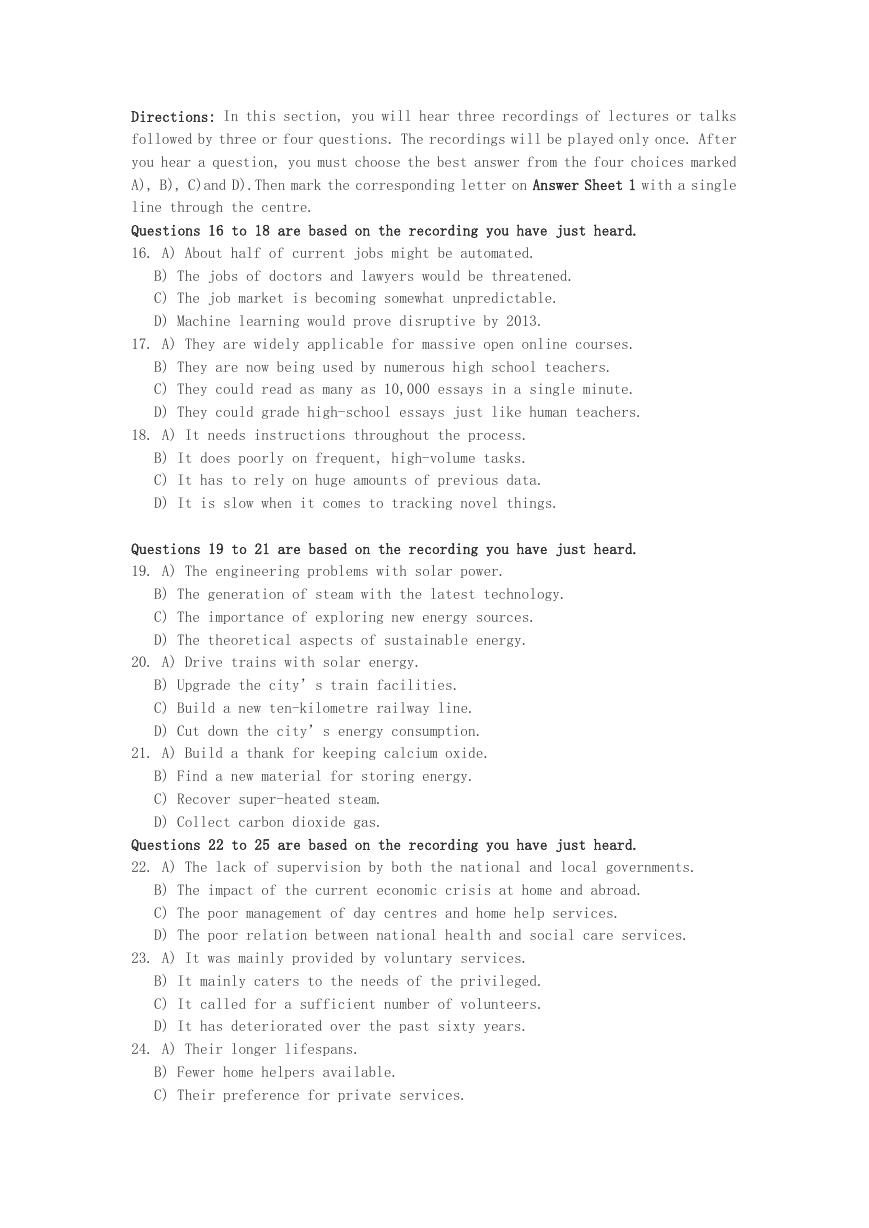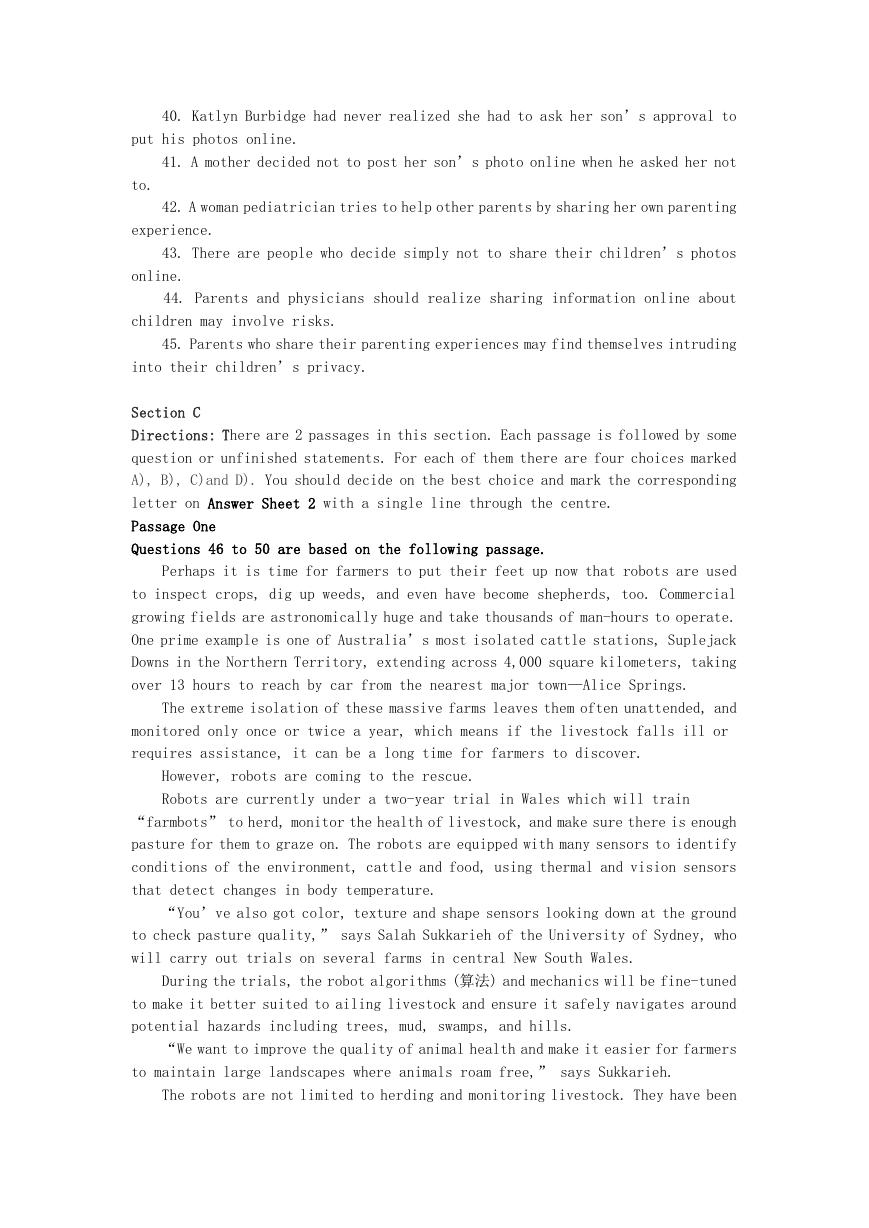2018 年 12 月英语六级真题(第 1 套)
Writing
(30 minutes)
Part I
Directions: For this part, you are allowed 30 minutes to write an essay on how to
balance work and leisure. You should write at least 150 words but no more than 200
words.
_______________________________________________________________________________
_______________________________________________________________________________
_______________________________________________________________________________
____________________________________________________________
(30
Listening Comprehension
Part II
minutes)
Section A
Directions: In this section, you will hear two long conversations At the end of each
conversation, you will hear four questions. Both the conversation and the questions
will be spoken only once. After you hear a question, you must choose the best answer
from the four choices marked A), B), C) and D). Then mark the corresponding letter
on Answer Sheet 1 with a single line through the centre.
Questions1 to 4 are based on the conversation you have just heard.
1. A) It can benefit professionals and non-professionals alike.
B) It lists the various challenges physicists are confronting.
C) It describes how some mysteries of physics were solved.
D) It is one of the most fascinating physics books ever written.
2. A) Physicists’ contribution to humanity.
B) Stories about some female physicists.
C) Historical evolution of modern physics.
D) Women’s changing attitudes to physics.
3. A) By exposing a lot of myths in physics.
B) By describing her own life experiences.
C) By including lots of fascinating knowledge.
D) By telling anecdotes about famous professors.
4. A) It avoids detailing abstract concepts of physics.
B) It contains a lot of thought-provoking questions.
C) It demonstrates how they can become physicists.
D) It provides experiments they can do themselves.
Questions 5 to 8 are based on the conversation you have just heard.
5. A) He is too busy to finish his assignment in time.
B) He does not know what kind of topic to write on.
C) He does not understand the professor’s instructions.
D) He has no idea how to proceed with his dissertation.
6. A) It is too broad.
C) It is challenging.
B) It is a bit outdated.
D) It is interesting.
�
7. A) Biography.
Beauty.
8. A) Improve his cumulative grade.
B) Nature.
C) Stick to the topic assigned.
C) Philosophy.
D)
B) Develop his reading ability.
D) List the parameters first.
Section B
Directions: In this section, you will hear two passages. At the end of each passage,
you will hear three or four questions. Both the passage and the questions will be
spoken only once. After you hear a question, you must choose the best answer from
the four choices marked A), B), C)and D). Then mark the corresponding letter on Answer
Sheet 1 with a single line through the centre.
Questions 9 to 11 are based on the passage you have just heard.
9. A) The unprecedented high temperature in Greenland.
B) The collapse of ice on the northern tip of Greenland.
C) The unusual cold spell in the Arctic area in October.
D) The rapid change of Arctic temperature within a day.
10. A) It has created a totally new climate pattern.
B) It will pose a serious threat to many species.
C) It typically appears about once every ten years.
D) It has puzzled the climate scientists for decades.
11. A) Extinction of Arctic wildlife.
B) Iceless summers in the Arctic.
C) Emigration of indigenous people.
D) Better understanding of ecosystems.
Questions 12 to 15 are based on the passage you have just heard.
12. A) A good start.
B) A detailed plan.
C) A strong determination.
D) A scientific approach.
13. A) Most people get energized after a sufficient rest.
B) Most people tend to have a finite source of energy.
C) It is vital to take breaks between demanding mental tasks.
D) It is most important to have confidence in one’s willpower.
14. A) They could keep on working longer.
B) They could do more challenging tasks.
C) They found it easier to focus on work at hand.
D) They held more positive attitudes toward life.
15. A) They are part of their nature.
B) They are subject to change.
C) They are related to culture.
D) They are beyond control.
Section C
�
Directions: In this section, you will hear three recordings of lectures or talks
followed by three or four questions. The recordings will be played only once. After
you hear a question, you must choose the best answer from the four choices marked
A), B), C)and D).Then mark the corresponding letter on Answer Sheet 1 with a single
line through the centre.
Questions 16 to 18 are based on the recording you have just heard.
16. A) About half of current jobs might be automated.
B) The jobs of doctors and lawyers would be threatened.
C) The job market is becoming somewhat unpredictable.
D) Machine learning would prove disruptive by 2013.
17. A) They are widely applicable for massive open online courses.
B) They are now being used by numerous high school teachers.
C) They could read as many as 10,000 essays in a single minute.
D) They could grade high-school essays just like human teachers.
18. A) It needs instructions throughout the process.
B) It does poorly on frequent, high-volume tasks.
C) It has to rely on huge amounts of previous data.
D) It is slow when it comes to tracking novel things.
Questions 19 to 21 are based on the recording you have just heard.
19. A) The engineering problems with solar power.
B) The generation of steam with the latest technology.
C) The importance of exploring new energy sources.
D) The theoretical aspects of sustainable energy.
20. A) Drive trains with solar energy.
B) Upgrade the city’s train facilities.
C) Build a new ten-kilometre railway line.
D) Cut down the city’s energy consumption.
21. A) Build a thank for keeping calcium oxide.
B) Find a new material for storing energy.
C) Recover super-heated steam.
D) Collect carbon dioxide gas.
Questions 22 to 25 are based on the recording you have just heard.
22. A) The lack of supervision by both the national and local governments.
B) The impact of the current economic crisis at home and abroad.
C) The poor management of day centres and home help services.
D) The poor relation between national health and social care services.
23. A) It was mainly provided by voluntary services.
B) It mainly caters to the needs of the privileged.
C) It called for a sufficient number of volunteers.
D) It has deteriorated over the past sixty years.
24. A) Their longer lifespans.
B) Fewer home helpers available.
C) Their preference for private services.
�
D) More of them suffering serious illnesses.
25. A) They are unable to pay for health services.
B) They have long been discriminated against.
C) They are vulnerable to illnesses and diseases.
D) They have contributed a great deal to society.
Part III
Reading Comprehension
(40 minutes)
Section A
Directions: In this section, there is a passage with ten blanks. You are required
to select one word for each blank from a list of choices given in a word bank following
the passage. Read the passage through carefully before making your choices. Each
choice in the bank is identified by a letter. Please mark the corresponding letter
for each item on Answer Sheet 2 with a single line through the centre. You may not
use any of the words in the bank more than once.
Questions 26 to 35 are based on the following passage.
Just off the coast of Southern California sits Santa Cruz Island, where a magical
. A decade ago, this island’s ecosystem
. Wild pigs attracted golden eagles from the mainland, and those
crashed the fox population. So the Nature Conservancy
war against the pigs, complete with helicopters and sharp
creature called the island fox
was in
flying
launched a
shooters.
26
27
28
29
And it worked. Today, federal agencies are pulling the island fox from the
Endangered Species List. It’s the fastest-ever recovery of a mammal, joining peers
like the Louisiana black bear as glowing successes in the history of the Endangered
Species Act.
30
But the recovery of Santa Cruz Island isn’t just about the fox. The Nature
war on a multitude of invasive species here, from
Conservancy has
Argentine ant. “Our philosophy with the
sheep to plants to the
island has always been, ‘OK,
the threats and let the island go back
to what it was,’” says ecologist Christina Boser. And it appears to be working.
Native plants are coming back, and the fox once again bounds about carefree.
32
31
But keeping those foxes from harm will occupy Boser and her colleagues for years
to come. You see, humans are still allowed on Santa Cruz Island, and they bring dogs.
So Boser has to vaccinate her foxes against various diseases. “We’re obligated
to keep a pulse on the population for at least five years after the foxes are
delisted,” says Boser. That includes tagging the foxes and
their
numbers to ensure nothing goes wrong.
33
This is the story of the little fox that has come back, and the people who
their lives to protecting it. This is the story of wildlife
34
have
conservation in the age of mass
35
.
�
A)aggressive
I)hinders
B)chaos
J)mammal
configuration
C)
K) monitoring
D)declared
L)predators
E)dedicated
M)remove
F)dwells
N) tempt
G)extinction
O)underlying
H)
fierce
Section B
Directions: In this section, you are going to read a passage with ten statements
attached to it. Each statement contains information given in one of the paragraphs.
Identify the paragraph from which the information is derived. You may choose a
paragraph more than once. Each paragraph is marked with a letter. Answer the
questions by marking the corresponding letter on Answer Sheet 2.
Do Parents Invade Children’s Privacy When They Post Photos
Online?
[A] When Katlyn Burbidge’s son was 6 years old, he was performing some
ridiculous song and dance typical of a first-grader. But after she snapped a photo
and started using her phone, he asked her a serious question:“Are you going to post
that online?” She laughed and answered, “Yes, I think I will.” What he said next
stopped her. “Can you not?”
[B] That’s when it dawned on her: She had been posting photos of him online
without asking his permission. “We’re big advocates of bodily autonomy and not
forcing him to hug or kiss people unless he wants to, but it never occurred to me
that I should ask his permission to post photos of him online,” says Burbidge, a
mom of two in Wakefield, Massachusetts. “Now when I post a photo of him online,
I show him the photo and get his okay.”
[C] When her 8-month-old is 3 or 4 years old, she plans to start asking him in
an age-appropriate way, “Do you want other people to see this?” That’s precisely
the approach that two researchers advocated before a room of pediatricians (儿科
医生) last week at the American Academy of Pediatrics meeting, when they discussed
the 21st century challenge of “sharenting,” a new term for parents’ online sharing
about their children. “As advocates of children’s rights, we believe that children
should have a voice about what information is shared about them if possible,” says
Stacey Steinberg, a legal skills professor at the University of Florida Levin College
�
of Law in Gainesville.
[D] Whether it’s ensuring that your child isn’t bullied over something you
post, that their identity isn’t digitally “kidnapped”, or that their photos
don’t end up on a half dozen child pornography (色情) sites, as one Australian mom
discovered, parents and pediatricians are increasingly aware of the importance of
protecting children’s digital presence. Steinberg and Bahareh Keith, an assistant
professor of pediatrics at the University of Florida College of Medicine, say most
children will likely never experience problems related to what their parents share,
but a tension still exists between parents’ rights to share their experiences and
their children’s rights to privacy.
[E] “We’re in no way trying to silence parents’ voices,” Steinberg says.
“At the same time, we recognize that children might have an interest in entering
adulthood free to create their own digital footprint.” They cited a study presented
earlier this year of 249 pairs of parents and their children in which twice as many
children as parents wanted rules on what parents could share. “The parents said,
‘We don’t need rules—we’re fine,’ and the children said, ‘Our parents need
rules,’” Keith says. “The children wanted autonomy about this issue and were
worried about their parents sharing information about them.”
[F] Although the American Academy of Pediatrics offers guidelines recommending
that parents model appropriate social media use for their children, it does not
explicitly discuss oversharing by parents. “I think this is a very legitimate
concern, and I appreciate their drawing our attention to it,” David Hill, a father
of five, says. He sees a role for pediatricians to talk with parents about this,
but believes the messaging must extend far beyond pediatricians’ offices. “I look
forward to seeing researchers expand our understanding of the issue so we can
translate it into effective education and policy,” he says.
[G] There’s been little research on the topic, Steinberg wrote in a law article
about this issue. While states could pass laws related to sharing information about
children online, Steinberg feels parents themselves are generally best suited to
make these decisions for their families. “While we didn’t want to create any
unnecessary panic, we did find some concerns that were troublesome, and we thought
that parents or at least physicians should be aware of those potential risks,”
Steinberg says. They include photos repurposed for inappropriate or illegal means,
identity theft, embarrassment, bullying by peers or digital kidnapping.
[H] But that’s the negative side, with risks that must be balanced against the
benefits of sharing. Steinberg pointed out that parental sharing on social media
helps build communities, connect spread-out families, provide support and raise
awareness around important social issues for which parents might be their
children’s only voice.
[I] A C.S. Mott survey found among the 56 percent of mothers and 34 percent of
fathers who discussed parenting on social media, 72 percent of them said sharing
made them feel less alone, and nearly as many said sharing helped them worry less
and gave them advice from other parents. The most common topics they discussed
included kids’ sleep, nutrition, discipline, behavior problems and day care and
�
preschool.
[J] “There’s this peer-to-peer nature of health care these days with a profound
opportunity for parents to learn helpful tips, safety and prevention efforts,
pro-vaccine messages and all kinds of other messages from other parents in their
social communities,” says Wendy Sue Swanson, a pediatrician and executive director
of digital health at Seattle Children’s Hospital, where she blogs about her own
parenting journey to help other parents. “They’re getting nurtured by people
they’ve already selected that they trust,” she says.
[K] “How do we weigh the risks, how do we think about the benefits, and how
do we alleviate the risks?” she says. “Those are the questions we need to ask
ourselves, and everyone can have a different answer.”
[L] Some parents find the best route for them is not to share at all. Bridget
O’Hanlon and her husband, who live in Cleveland, decided before their daughter was
born that they would not post her photos online. When a few family members did post
pictures, O’Hanlon and her husband made their wishes clear. “It’s been hard not
to share pictures of her because people always want to know how babies and toddlers
(学走路的孩子) are doing and to see pictures, but we made the decision to have social
media while she did not,” O’Hanlon said. Similarly, Alison Jamison of New York
decided with her husband that their child had a right to their own online identity.
They did use an invitation-only photo sharing platform so that friends and family,
including those far away, could see the photos, but they stood firm, simply refusing
to put their child’s photos on other social media platforms.
[M] “For most families, it’s a journey. Sometimes it goes wrong, but most of
the time it doesn’t,” says Swanson, who recommends starting to ask children
permission to post narratives or photos around ages 6 to 8. “We’ll learn more and
more what our tolerance is. We can ask our kids to help us learn as a society what’s
okay and what’s not.”
[N] Indeed, that learning process goes both ways. Bria Dunham, a mother in
Somerville, Massachusetts, was so excited to watch a moment of brotherly bonding
while her first-grader and baby took a bath together that she snapped a few photos.
But when she considered posting them online, she took the perspective of her son:
How would he feel if his classmates’ parents saw photos of him chest-up in the
bathtub? “It made me think about how I’m teaching him to have ownership of his
own body and how what is shared today endures into the future,” Dunham says. “So
I kept the pictures to myself and accepted this as one more step in supporting his
increasing autonomy.”
36. Steinberg argued parental sharing online can be beneficial.
37. According to an expert, when children reach school age, they can help their
parents learn what can and cannot be done.
38. One mother refrained from posting her son’s photos online when she
considered the matter from her son’s perspective.
39. According to a study, more children than parents think there should be rules
on parents’ sharing.
�
40. Katlyn Burbidge had never realized she had to ask her son’s approval to
put his photos online.
41. A mother decided not to post her son’s photo online when he asked her not
to.
42. A woman pediatrician tries to help other parents by sharing her own parenting
experience.
43. There are people who decide simply not to share their children’s photos
online.
44. Parents and physicians should realize sharing information online about
children may involve risks.
45. Parents who share their parenting experiences may find themselves intruding
into their children’s privacy.
Section C
Directions: There are 2 passages in this section. Each passage is followed by some
question or unfinished statements. For each of them there are four choices marked
A), B), C)and D). You should decide on the best choice and mark the corresponding
letter on Answer Sheet 2 with a single line through the centre.
Passage One
Questions 46 to 50 are based on the following passage.
Perhaps it is time for farmers to put their feet up now that robots are used
to inspect crops, dig up weeds, and even have become shepherds, too. Commercial
growing fields are astronomically huge and take thousands of man-hours to operate.
One prime example is one of Australia’s most isolated cattle stations, Suplejack
Downs in the Northern Territory, extending across 4,000 square kilometers, taking
over 13 hours to reach by car from the nearest major town—Alice Springs.
The extreme isolation of these massive farms leaves them often unattended, and
monitored only once or twice a year, which means if the livestock falls ill or
requires assistance, it can be a long time for farmers to discover.
However, robots are coming to the rescue.
Robots are currently under a two-year trial in Wales which will train
“farmbots” to herd, monitor the health of livestock, and make sure there is enough
pasture for them to graze on. The robots are equipped with many sensors to identify
conditions of the environment, cattle and food, using thermal and vision sensors
that detect changes in body temperature.
“You’ve also got color, texture and shape sensors looking down at the ground
to check pasture quality,” says Salah Sukkarieh of the University of Sydney, who
will carry out trials on several farms in central New South Wales.
During the trials, the robot algorithms (算法) and mechanics will be fine-tuned
to make it better suited to ailing livestock and ensure it safely navigates around
potential hazards including trees, mud, swamps, and hills.
“We want to improve the quality of animal health and make it easier for farmers
to maintain large landscapes where animals roam free,” says Sukkarieh.
The robots are not limited to herding and monitoring livestock. They have been
�
















 2023年江西萍乡中考道德与法治真题及答案.doc
2023年江西萍乡中考道德与法治真题及答案.doc 2012年重庆南川中考生物真题及答案.doc
2012年重庆南川中考生物真题及答案.doc 2013年江西师范大学地理学综合及文艺理论基础考研真题.doc
2013年江西师范大学地理学综合及文艺理论基础考研真题.doc 2020年四川甘孜小升初语文真题及答案I卷.doc
2020年四川甘孜小升初语文真题及答案I卷.doc 2020年注册岩土工程师专业基础考试真题及答案.doc
2020年注册岩土工程师专业基础考试真题及答案.doc 2023-2024学年福建省厦门市九年级上学期数学月考试题及答案.doc
2023-2024学年福建省厦门市九年级上学期数学月考试题及答案.doc 2021-2022学年辽宁省沈阳市大东区九年级上学期语文期末试题及答案.doc
2021-2022学年辽宁省沈阳市大东区九年级上学期语文期末试题及答案.doc 2022-2023学年北京东城区初三第一学期物理期末试卷及答案.doc
2022-2023学年北京东城区初三第一学期物理期末试卷及答案.doc 2018上半年江西教师资格初中地理学科知识与教学能力真题及答案.doc
2018上半年江西教师资格初中地理学科知识与教学能力真题及答案.doc 2012年河北国家公务员申论考试真题及答案-省级.doc
2012年河北国家公务员申论考试真题及答案-省级.doc 2020-2021学年江苏省扬州市江都区邵樊片九年级上学期数学第一次质量检测试题及答案.doc
2020-2021学年江苏省扬州市江都区邵樊片九年级上学期数学第一次质量检测试题及答案.doc 2022下半年黑龙江教师资格证中学综合素质真题及答案.doc
2022下半年黑龙江教师资格证中学综合素质真题及答案.doc